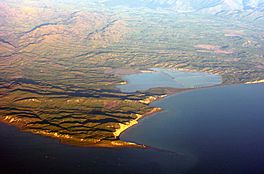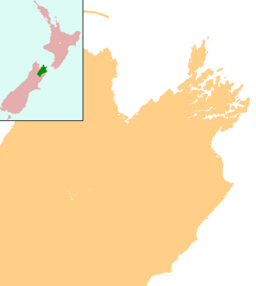Lake Grassmere facts for kids
Quick facts for kids Lake Grassmere / Kapara Te Hau |
|
|---|---|

Lake Grassmere
|
|
| Location | Marlborough Region, South Island |
| Coordinates | 41°44′S 174°10′E / 41.733°S 174.167°E |
| Type | lagoon |
| Primary inflows | none |
| Basin countries | New Zealand |
| Surface area | 17 km2 (6.6 sq mi) |
Lake Grassmere / Kapara Te Hau is a special type of lake called a lagoon in New Zealand. It's located in the northeastern part of the South Island, not far from Cook Strait. This lake is famous because it's used to make salt!
Contents
Where is Lake Grassmere?
Lake Grassmere is about 25 miles (40 km) south of Blenheim. It's a shallow lake that is protected from the open ocean by a sandy beach with sand dunes.
The lake covers an area of about 17 square kilometres (6.6 sq mi). It doesn't have any natural rivers flowing into it. The lake is also very close to the sea, which means its water is very salty. This high saltiness is called salinity.
The lake's size can change, usually between 3,500 and 4,400 acres (14 and 18 km2). It only reaches its largest size during rare floods.
Why is Lake Grassmere good for salt?
Lake Grassmere is perfect for making salt naturally. This is because it has:
- No natural rivers flowing in to dilute the salt.
- Strong, warm winds that help water evaporate.
- Very high saltiness because it's near the sea.
- A low average rainfall of 585 millimetres (23.0 in).
These conditions help the water evaporate quickly, leaving the salt behind.
What is the climate like?
The climate at Lake Grassmere is very important for salt production. It has warm temperatures and low rainfall, especially in summer. This helps the water in the lake evaporate, which is how salt is collected.
| Climate data for Grassmere Salt Works (1991–2020) | |||||||||||||
|---|---|---|---|---|---|---|---|---|---|---|---|---|---|
| Month | Jan | Feb | Mar | Apr | May | Jun | Jul | Aug | Sep | Oct | Nov | Dec | Year |
| Mean daily maximum °C (°F) | 22.4 (72.3) |
22.0 (71.6) |
20.7 (69.3) |
18.0 (64.4) |
15.9 (60.6) |
13.4 (56.1) |
12.7 (54.9) |
13.7 (56.7) |
15.6 (60.1) |
17.5 (63.5) |
19.2 (66.6) |
21.0 (69.8) |
17.7 (63.8) |
| Daily mean °C (°F) | 18.5 (65.3) |
18.2 (64.8) |
16.7 (62.1) |
14.1 (57.4) |
11.9 (53.4) |
9.4 (48.9) |
8.8 (47.8) |
9.9 (49.8) |
11.8 (53.2) |
13.5 (56.3) |
15.3 (59.5) |
17.2 (63.0) |
13.8 (56.8) |
| Mean daily minimum °C (°F) | 14.6 (58.3) |
14.4 (57.9) |
12.8 (55.0) |
10.2 (50.4) |
7.8 (46.0) |
5.3 (41.5) |
4.9 (40.8) |
6.0 (42.8) |
8.0 (46.4) |
9.6 (49.3) |
11.4 (52.5) |
13.4 (56.1) |
9.9 (49.8) |
| Average rainfall mm (inches) | 36 (1.4) |
37.4 (1.47) |
38.3 (1.51) |
46.3 (1.82) |
47.3 (1.86) |
69.3 (2.73) |
60.4 (2.38) |
52.0 (2.05) |
45.7 (1.80) |
39.9 (1.57) |
46.7 (1.84) |
42.6 (1.68) |
561.9 (22.11) |
| Source: NIWA | |||||||||||||
Early History of the Lake
The Māori name for the lake is Kapara Te Hau, which means "wind-blown lake." Early whalers in the area called it "Cobblers' Hole."
Māori Legends and Use
According to Māori stories, the lake was once a place where people grew crops. A famous navigator named Kupe is said to have poured salt water onto these crops, creating the lake.
Before Europeans arrived, the lake was an important source of food. Many different kinds of waterfowl (birds that live on water) were attracted to the lake, making it a good place to hunt.
A Battle at the Lake
In 1832–33, a battle took place near the lake. The Ngāti Toa tribe, led by Te Rauparaha, came to the lake to hunt ducks. The Ngāi Tahu tribe knew they were coming and set up a surprise attack.
Te Rauparaha's scouts thought the area was empty, so the canoes landed. But the Ngāi Tahu attacked, and many Ngāti Toa warriors were hurt. Te Rauparaha was captured by Tūhawaiki. However, Te Rauparaha tricked his captors, slipped out of his clothes, and swam to a canoe to escape.
The Salt Industry
Before the 1940s, Lake Grassmere was often muddy in winter and dusty in summer. Sometimes, natural salt deposits would form.
How Salt is Made
The salt industry started at Lake Grassmere in 1943. Today, it uses about one-third of the lake's suitable area, which is about 3,800 acres (15 km2).
Here's how they make salt:
- The lake has been divided into many smaller ponds.
- Seawater is pumped into these ponds.
- Over several months, the water is moved from one pond to another.
- As the water moves, the sun and wind make it evaporate.
- With each evaporation, the water gets saltier.
- Eventually, the salt turns into crystals, which are then collected. This is called solar evaporation.
Salt Production and Use
In 1960, Lake Grassmere produced 17,000 tons of salt. New Zealand used about 61,000 tons of salt that year for homes and industries.
By 2005, Lake Grassmere was providing about half of all the salt New Zealand needed. The harvest for 1964–65 reached 30,000 tons, which was a record at the time. By 1970, the harvest grew to almost 52,000 tonnes.
However, this still wasn't enough for New Zealand's growing industries, like meat processing and paper mills. So, salt also started to be shipped in from other countries.
Some old railway equipment from the Grassmere salt works is now kept at the Ferrymead Two Foot Railway.
Types of Salt Produced
Lake Grassmere produces many different types of salt. These salts have slightly different chemical makeups, and their crystals come in various sizes and shapes.
All table salt made in New Zealand comes from solar salt, like that from Lake Grassmere. You can find both iodised and non-iodised table salt.
- Iodised salt has added iodine. This is important because iodine helps prevent a health problem called goitre. It also contains silicon dioxide to stop the salt from clumping.
- Specialty salts, like flaky salt, are also made at Lake Grassmere.
The salt works also produce products for animal health, such as salt licks for farm animals.
At the end of summer, you can easily see the bright white salt piles from State Highway 1. They stand out against the brown hills of Marlborough.
Earthquakes at Lake Grassmere
A fault line runs underneath Lake Grassmere. On Friday, August 16, 2013, at 2:31:05 pm, this fault caused a magnitude 6.6 earthquake.
The earthquake was about 8 kilometres (5 mi) deep. It was a strike-slip fault earthquake, similar to another quake that happened on July 21, 2013, near Seddon. Because of this, it was considered a doublet earthquake, meaning two large quakes happened close together in time and location.
Official Name of the Lake
The official name of the lake is now a dual name: Lake Grassmere / Kapara Te Hau. This change happened because of the Ngāi Tahu Claims Settlement Act 1998.


